Intel's Haswell Architecture Analyzed: Building a New PC and a New Intel
by Anand Lal Shimpi on October 5, 2012 2:45 AM ESTPlatform Retargeting
Since the introduction of Conroe/Merom back in 2006 Intel has been prioritizing notebooks for the majority of its processor designs. The TDP target for these architectures was set around 35 - 45W. Higher and lower TDPs were hit by binning and scaling voltage. The rule of thumb is a single architecture can efficiently cover an order of magnitude of TDPs. In the case of these architectures we saw them scale all the way up to 130W and all the way down to 17W.

In the middle of 2011 Intel announced its Ultrabook initiative, and at the same time mentioned that Haswell would shift Intel's notebook design target from 35 - 45W down to 10 - 20W.
At the time I didn't think too much about the new design target, but everything makes a lot more sense now. This isn't a "simple" architectural shift, it's a complete rethinking of how Intel approaches platform design. More importantly than Haswell's 10 - 20W design point, is the new expanded SoC design target. I'll get to the second part shortly.
Platform Power
There will be four client focused categories of Haswell, and I can only talk about three of them now. There are the standard voltage desktop parts, the mobile parts and the ultra-mobile parts: Haswell, Haswell M and Haswell U. There's a fourth category of Haswell that may happen but a lot is still up in the air on that line.
Of the three that Intel is talking about now, the first two (Haswell/Haswell M) don't do anything revolutionary on the platform power side. Intel is promising around a 20% reduction in platform power compared to Sandy Bridge, but not the order of magnitude improvement it promised at IDF. These platforms are still two-chip solutions with the SoC and a secondary IO chip similar to what we have today with Ivy Bridge + PCH.
It's the Haswell U/ULT parts that brings about the dramatic change. These will be a single chip solution, with part of the voltage regulation typically found on motherboards moved onto the chip's package instead. There will still be some VR components on the motherboard as far as I can tell, it's the specifics that are lacking at this point (which seems to be much of the theme of this year's IDF).
Seven years ago Intel first demonstrated working silicon with an on-chip North Bridge (now commonplace) and on-package CMOS voltage regulation:
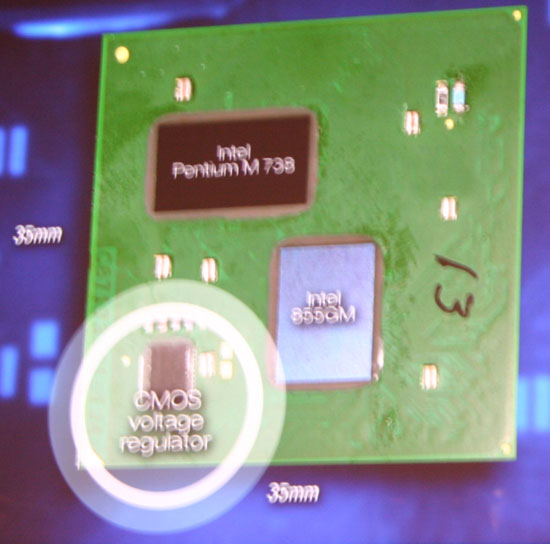
The benefits were two-fold: 1) Intel could manage fine grained voltage regulation with very fast transition times and 2) a tangible reduction in board component count.
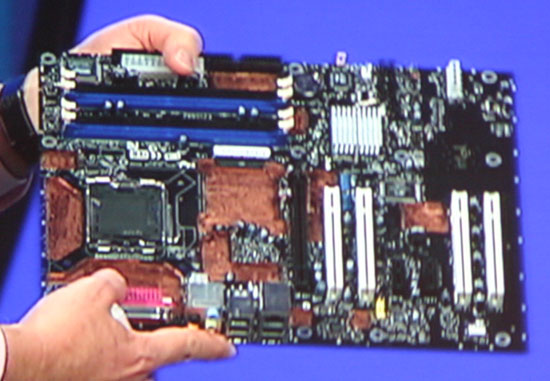
2005 - A prototype motherboard using the technology. Note the lack of voltage regulators on the motherboard and the missing GMCH (North Bridge) chip.
The second benefit is very easy to understand from a mobile perspective. Fewer components on a motherboard means smaller form factors and/or more room for other things (e.g. larger battery volume via a reduction in PCB size).
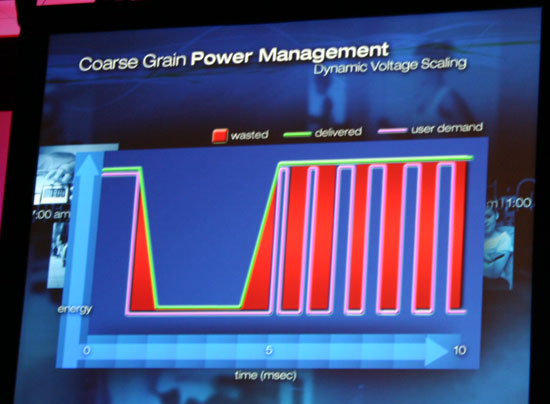

The first benefit made a lot of sense at the time when Intel introduced it, but it makes even more sense when you consider the most dramatic change to Haswell: support for S0ix active idle.


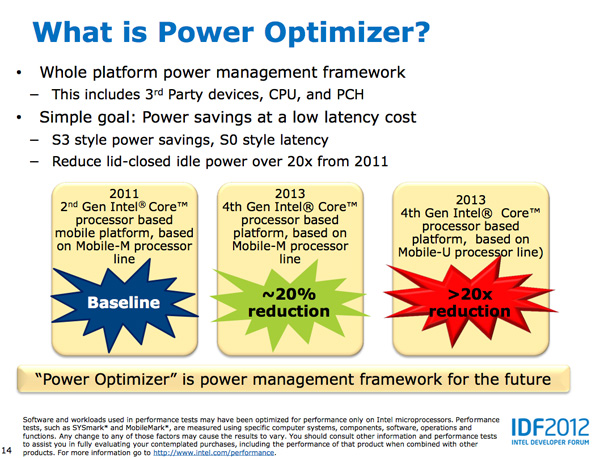
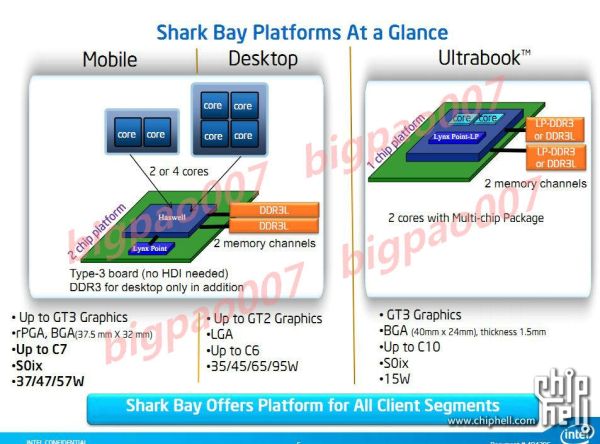








245 Comments
View All Comments
stop-a - Saturday, October 6, 2012 - link
100% agree on the well engineered part especially on the antenna gate when Steve God was saying "you're holding wrong", plus the recently ingeniously designed sapphire glass lens camera when Tim Schmok was saying "stay away from bright light source". Boy, Apple products must be engineered straight from the heaven; they are just too perfect for a mere earthling to use.Paer0 - Saturday, October 6, 2012 - link
@stop-a. Since you are a 100% Apple hater, let me ask you this what computer do you use? And what OS do you use on it? I hope it doesn't crash several times a day. I use a MacBook Pro 2012 and I don't see anything come close.Urizane - Saturday, October 6, 2012 - link
You really shouldn't use the 'crash several times a day' piece anymore. I'm annoyed every time I see this. My Windows 7 machine has an uptime of 20 days and counting. Most of the time, it waits for me to connect to it via SplashTop or FTP, or it's recording TV shows, but when I play games, I stress it bigtime. Seriously, stop with the Windows constantly crashes crap. It's just plain false now.P.S. - 20 days ago, I brought it to another house, thus the interruption in uptime.
StevoLincolnite - Saturday, October 6, 2012 - link
I have a Dual socket 2011 motherboard with dual Core i7 3930K's both chips clocked to 4.6ghz, 32gb of ram, Triple Radeon 7970 3gb cards powering 3x 27" Dell U2711 monitors in Eyefinity.Kay go. Lets see if your Mac can keep up or a Mac workstation at the same price. (Hint: Not going to happen.)
Besides, Mac's look ugly, I prefer the whole she-bang of a side window with a nice water cooling loop and having the whole thing light up, not some dull silver box.
Plus, my system is completely stable. Never had a crash yet with Windows 7 and... I have access to the last couple of decades worth of software and games, not to mention emulation of other platforms.
I can also pretty much find software and hardware easily and it will "just work" I never have to ask the question of: Will it work on a Mac?
lmcd - Saturday, October 6, 2012 - link
I don't think you're in their target audience, for some reason. They're the best preconfigured system out there, especially once you ignore price.Magik_Breezy - Sunday, October 14, 2012 - link
You'd hope a manufacturer can "configure" a system for an extra $1,400Hardware: $400
I'm Apple: $1,400
Total: $1,800
With PCs manufacturers almost always loose money selling motherboards
vt1hun - Tuesday, October 9, 2012 - link
Two Core i7s working on a dual 2011 socket motherboard? You need QPI links for that which only certain Xeons have. Sounds like your system will just NOT work !FunBunny2 - Tuesday, October 9, 2012 - link
If Steve hadn't done what Apple does best (according to Steve) "steal" BSD unix, would you still be crowing?Magik_Breezy - Sunday, October 14, 2012 - link
His operating system doesn't crash 7 times a day because he doesn't run OS X, I'll rephrase that, because he isn't a retardHisDivineOrder - Sunday, October 7, 2012 - link
Let's not forget the obscenely high failure rates due of Macbook Pro's because they are huge, metallic, and yet refuse to have vents ruin the smooth awesomeness of their aesthetic.Whoops, for many it won't last more than two years, if that. Hell, if you're lucky, your battery will give out before your laptop cooks. Regardless, look up what Apple suggests and you'll get:
Buy another one. Yours is old. ;)